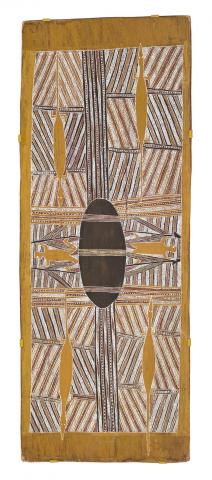DJAN'KAWU AT YALANGBARA, c.1961
Mawalan Marika
natural earth pigments on eucalyptus bark
117.0 x 44.5 cm
Painted at Yirrkala North East Arnhem Land
Dorothy Bennett, Darwin (label attached verso)
Private collection, Adelaide
Sotheby's, Melbourne, 24 June 2002, lot 301
Lauraine Diggins Fine Art, Melbourne (label attached verso)
Private collection, Melbourne
The descriptive label on the reverse reads: 'This is one of the dances performed in a sacred ceremony The Djungguan. The Wawilak (sic) Sisters wandered throughout Arnhem Land naming plants animals and fish reptiles and places killing many animals and fish. When they arrived at well of Mirrirmina (rock pythons back) they made a fire and threw the food on to it but immediately everything came to life and ran into the sacred well and thus became totemic emblems. Yurlungurr the giant python came out of the well and swallowed the Wawilak Sisters. In a desperate attempt to avoid themselves from being swallowed the sisters had sung and danced all the taboo songs and dances they could think of starting with the crab dance as the crab had been the first to jump from the fire and run sideways down to the well. Yurlungurr took the sisters back through the subterraneum waters beneath the well to their own country and regurgitated them onto dry land. They appeared in a dream to two Wongar men and told them that all the people must dance the same dances and sing the same songs as they had before being swallowed and these were to be performed at the time of the circumcision rites. Each sister had had a baby with her at the well and had intended to circumcise them but now they passed on instructions to the men to do this for them. Here two men representing the Wongar mythological figures dance with woomeras and spears around a sacred well. Goannas shown represent one of the totems of the artist handed down to him by his father.'
